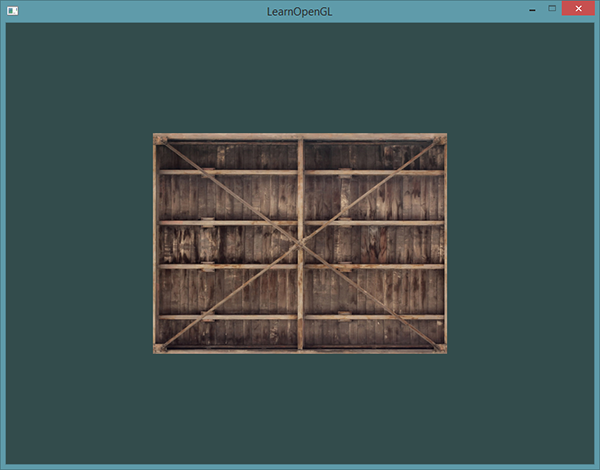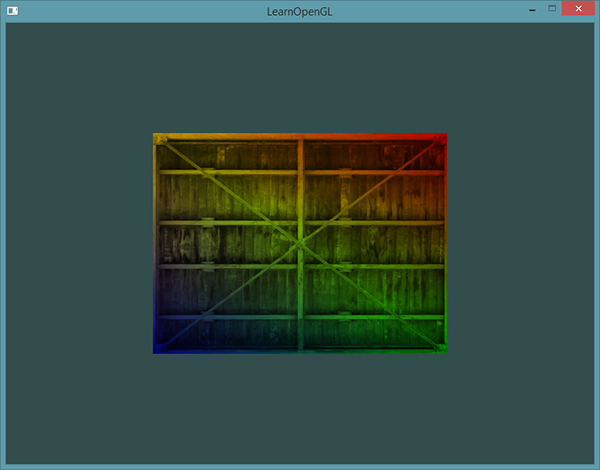LearnOpenGL 9 纹理
LearnOpenGL CN 相关链接:https://learnopengl-cn.github.io/01%20Getting%20started/06%20Textures/
本节视频:暂未发布
使用到的素材(右键-将图像另存为)
文件为 Joey de Vries 所有。所有权利均保留。 All credit goes to Joey de Vries. All rights reserved.
本节代码(点击展开)
普通的木箱子
1
2
3
4
5
6
7
8
9
10
11
12
13
14
15
16
17
18
19
20
21
22
23
24
25
26
27
28
29
30
31
32
33
34
35
36
37
38
39
40
41
42
43
44
45
46
47
48
49
50
51
52
53
54
55
56
57
58
59
60
61
62
63
64
65
66
67
68
69
70
71
72
73
74
75
76
77
78
79
80
81
82
83
84
85
86
87
88
89
90
91
92
93
94
95
96
97
98
99
100
101
102
103
104
105
106
107
108
# 导入需要的库
import glfw
import moderngl as mgl
import numpy as np
from PIL import Image
# 初始化 GLFW
if not glfw.init():
raise Exception('GLFW出错')
# 创建窗口
window = glfw.create_window(800, 600, 'LearnOpenGL', None, None)
if not window:
glfw.terminate()
raise Exception('window出错')
# 获得上下文
glfw.make_context_current(window)
ctx = mgl.create_context()
# 视口
def framebuffer_size_callback(window, width, height):
ctx.viewport = (0, 0, width, height)
glfw.set_framebuffer_size_callback(window, framebuffer_size_callback)
# 处理输入
def process_input(window):
if glfw.get_key(window, glfw.KEY_ESCAPE) == glfw.PRESS:
glfw.set_window_should_close(window, True)
# 着色器程序
vertex_shader = '''
#version 330 core
in vec3 in_vert;
in vec2 in_texcoord;
out vec2 v_texcoord;
void main()
{
gl_Position = vec4(in_vert, 1.0);
v_texcoord = in_texcoord;
}
'''
fragment_shader = '''
#version 330 core
in vec2 v_texcoord;
uniform sampler2D ourTexture;
out vec4 FragColor;
void main()
{
FragColor = texture(ourTexture, v_texcoord);
}
'''
prog = ctx.program(vertex_shader, fragment_shader)
# 顶点数据
vertices = np.array([
# ----- 位置 ----- - 纹理坐标 -
0.5, 0.5, 0.0, 1.0, 1.0, # 右上
0.5, -0.5, 0.0, 1.0, 0.0, # 右下
-0.5, -0.5, 0.0, 0.0, 0.0, # 左下
-0.5, 0.5, 0.0, 0.0, 1.0 # 左上
], dtype='f4')
vbo = ctx.buffer(vertices.tobytes())
indices = np.array([
0, 1, 3, # 第一个三角形
1, 2, 3 # 第二个三角形
], dtype='i4')
ibo = ctx.buffer(indices.tobytes())
# 顶点数组对象
vao = ctx.vertex_array(prog, vbo, 'in_vert', 'in_texcoord', index_buffer=ibo)
# 纹理
img = Image.open('container.jpg')
texture = ctx.texture(img.size, components=3, data=img.tobytes())
# 绑定纹理
prog['ourTexture'] = 0
texture.use(0)
# 渲染循环
while not glfw.window_should_close(window):
# 输入
process_input(window)
# 渲染指令
ctx.clear(0.2, 0.3, 0.3)
vao.render(mgl.TRIANGLES)
# 处理事件、交换缓冲
glfw.poll_events()
glfw.swap_buffers(window)
# 终止 GLFW
glfw.terminate()
70年代迪斯科木箱子
1
2
3
4
5
6
7
8
9
10
11
12
13
14
15
16
17
18
19
20
21
22
23
24
25
26
27
28
29
30
31
32
33
34
35
36
37
38
39
40
41
42
43
44
45
46
47
48
49
50
51
52
53
54
55
56
57
58
59
60
61
62
63
64
65
66
67
68
69
70
71
72
73
74
75
76
77
78
79
80
81
82
83
84
85
86
87
88
89
90
91
92
93
94
95
96
97
98
99
100
101
102
103
104
105
106
107
108
109
110
111
112
# 导入需要的库
import glfw
import moderngl as mgl
import numpy as np
from PIL import Image
# 初始化 GLFW
if not glfw.init():
raise Exception('GLFW出错')
# 创建窗口
window = glfw.create_window(800, 600, 'LearnOpenGL', None, None)
if not window:
glfw.terminate()
raise Exception('window出错')
# 获得上下文
glfw.make_context_current(window)
ctx = mgl.create_context()
# 视口
def framebuffer_size_callback(window, width, height):
ctx.viewport = (0, 0, width, height)
glfw.set_framebuffer_size_callback(window, framebuffer_size_callback)
# 处理输入
def process_input(window):
if glfw.get_key(window, glfw.KEY_ESCAPE) == glfw.PRESS:
glfw.set_window_should_close(window, True)
# 着色器程序
vertex_shader = '''
#version 330 core
in vec3 in_vert;
in vec3 in_color;
in vec2 in_texcoord;
out vec3 v_color;
out vec2 v_texcoord;
void main()
{
gl_Position = vec4(in_vert, 1.0);
v_color = in_color;
v_texcoord = in_texcoord;
}
'''
fragment_shader = '''
#version 330 core
in vec3 v_color;
in vec2 v_texcoord;
uniform sampler2D ourTexture;
out vec4 FragColor;
void main()
{
FragColor = texture(ourTexture, v_texcoord) * vec4(v_color, 1.0);
}
'''
prog = ctx.program(vertex_shader, fragment_shader)
# 顶点数据
vertices = np.array([
# ----- 位置 ----- ---- 颜色 ---- - 纹理坐标 -
0.5, 0.5, 0.0, 1.0, 0.0, 0.0, 1.0, 1.0, # 右上
0.5, -0.5, 0.0, 0.0, 1.0, 0.0, 1.0, 0.0, # 右下
-0.5, -0.5, 0.0, 0.0, 0.0, 1.0, 0.0, 0.0, # 左下
-0.5, 0.5, 0.0, 1.0, 1.0, 0.0, 0.0, 1.0 # 左上
], dtype='f4')
vbo = ctx.buffer(vertices.tobytes())
indices = np.array([
0, 1, 3, # 第一个三角形
1, 2, 3 # 第二个三角形
], dtype='i4')
ibo = ctx.buffer(indices.tobytes())
# 顶点数组对象
vao = ctx.vertex_array(prog, vbo, 'in_vert', 'in_color', 'in_texcoord', index_buffer=ibo)
# 纹理
img = Image.open('container.jpg')
texture = ctx.texture(img.size, components=3, data=img.tobytes())
# 绑定纹理
prog['ourTexture'] = 0
texture.use(0)
# 渲染循环
while not glfw.window_should_close(window):
# 输入
process_input(window)
# 渲染指令
ctx.clear(0.2, 0.3, 0.3)
vao.render(mgl.TRIANGLES)
# 处理事件、交换缓冲
glfw.poll_events()
glfw.swap_buffers(window)
# 终止 GLFW
glfw.terminate()
开心的箱子
1
2
3
4
5
6
7
8
9
10
11
12
13
14
15
16
17
18
19
20
21
22
23
24
25
26
27
28
29
30
31
32
33
34
35
36
37
38
39
40
41
42
43
44
45
46
47
48
49
50
51
52
53
54
55
56
57
58
59
60
61
62
63
64
65
66
67
68
69
70
71
72
73
74
75
76
77
78
79
80
81
82
83
84
85
86
87
88
89
90
91
92
93
94
95
96
97
98
99
100
101
102
103
104
105
106
107
108
109
110
111
112
113
# 导入需要的库
import glfw
import moderngl as mgl
import numpy as np
from PIL import Image
# 初始化 GLFW
if not glfw.init():
raise Exception('GLFW出错')
# 创建窗口
window = glfw.create_window(800, 600, 'LearnOpenGL', None, None)
if not window:
glfw.terminate()
raise Exception('window出错')
# 获得上下文
glfw.make_context_current(window)
ctx = mgl.create_context()
# 视口
def framebuffer_size_callback(window, width, height):
ctx.viewport = (0, 0, width, height)
glfw.set_framebuffer_size_callback(window, framebuffer_size_callback)
# 处理输入
def process_input(window):
if glfw.get_key(window, glfw.KEY_ESCAPE) == glfw.PRESS:
glfw.set_window_should_close(window, True)
# 着色器程序
vertex_shader = '''
#version 330 core
in vec3 in_vert;
in vec2 in_texcoord;
out vec2 v_texcoord;
void main()
{
gl_Position = vec4(in_vert, 1.0);
v_texcoord = in_texcoord;
}
'''
fragment_shader = '''
#version 330 core
in vec2 v_texcoord;
uniform sampler2D texture1;
uniform sampler2D texture2;
out vec4 FragColor;
void main()
{
FragColor = mix(texture(texture1, v_texcoord), texture(texture2, v_texcoord), 0.2);
}
'''
prog = ctx.program(vertex_shader, fragment_shader)
# 顶点数据
vertices = np.array([
# ----- 位置 ----- - 纹理坐标 -
0.5, 0.5, 0.0, 1.0, 1.0, # 右上
0.5, -0.5, 0.0, 1.0, 0.0, # 右下
-0.5, -0.5, 0.0, 0.0, 0.0, # 左下
-0.5, 0.5, 0.0, 0.0, 1.0 # 左上
], dtype='f4')
vbo = ctx.buffer(vertices.tobytes())
indices = np.array([
0, 1, 3, # 第一个三角形
1, 2, 3 # 第二个三角形
], dtype='i4')
ibo = ctx.buffer(indices.tobytes())
# 顶点数组对象
vao = ctx.vertex_array(prog, vbo, 'in_vert', 'in_texcoord', index_buffer=ibo)
# 纹理
img = Image.open('container.jpg').transpose(Image.FLIP_TOP_BOTTOM)
texture1 = ctx.texture(img.size, components=3, data=img.tobytes())
img = Image.open('awesomeface.png').transpose(Image.FLIP_TOP_BOTTOM)
texture2 = ctx.texture(img.size, components=4, data=img.tobytes())
# 绑定纹理
prog['texture1'] = 0
prog['texture2'] = 1
texture1.use(0)
texture2.use(1)
# 渲染循环
while not glfw.window_should_close(window):
# 输入
process_input(window)
# 渲染指令
ctx.clear(0.2, 0.3, 0.3)
vao.render(mgl.TRIANGLES)
# 处理事件、交换缓冲
glfw.poll_events()
glfw.swap_buffers(window)
# 终止 GLFW
glfw.terminate()
本文由作者按照 CC BY 4.0 进行授权




